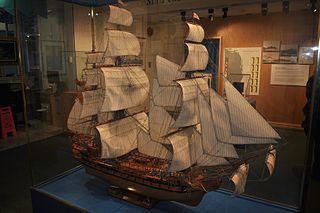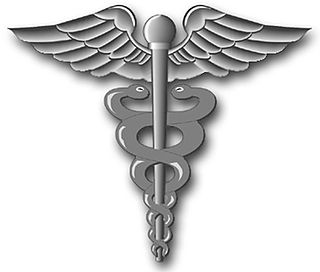
James Lind was a Scottish physician. He was a pioneer of naval hygiene in the Royal Navy. By conducting one of the first ever clinical trials, he developed the theory that citrus fruits cured scurvy.

A hospital ship is a ship designated for primary function as a floating medical treatment facility or hospital. Most are operated by the military forces of various countries, as they are intended to be used in or near war zones. In the 19th century, redundant warships were used as moored hospitals for seamen.
A midshipman is an officer of the lowest rank in the Royal Navy, United States Navy, and many Commonwealth navies. Commonwealth countries which use the rank include Canada, Australia, Bangladesh, Namibia, New Zealand, South Africa, India, Pakistan, Singapore, Sri Lanka, and Kenya.

Sir Gilbert Blane of Blanefield, 1st Baronet FRSE FRS MRCP was a Scottish physician who instituted health reform in the Royal Navy. He saw action against both the French and Spanish fleets, and later served as a Commissioner on the Sick and Wounded Board of the Admiralty. He was President of the Medical and Chirurgical Society of London in 1813.

HMAS Hobart was a modified Leander-class light cruiser which served in the Royal Australian Navy (RAN) during World War II. Originally constructed for the Royal Navy as HMS Apollo, the ship entered service in 1936, and was sold to Australia two years later. During the war, Hobart was involved in the evacuation of British Somaliland in 1940, fought at the Battle of the Coral Sea and supported the amphibious landings at Guadalcanal and Tulagi in 1942. She was torpedoed by a Japanese submarine in 1943, then returned to service in 1945 and supported the landings at Tarakan, Wewak, Brunei, and Balikpapan. Hobart was placed in reserve in 1947, but plans to modernise her and return her to service as an aircraft carrier escort, training ship, or guided missile ship were not followed through. The cruiser was sold for scrapping in 1962.

HMAS Australia was one of three Indefatigable-class battlecruisers built for the defence of the British Empire. Ordered by the Australian government in 1909, she was launched in 1911, and commissioned as flagship of the fledgling Royal Australian Navy (RAN) in 1913. Australia was the only capital ship to serve in the RAN.

William Redfern was the Surgeon’s First Mate aboard HMS Standard during the May 1797 Nore mutiny, and at a court martial in August 1797 he was sentenced to death for his involvement. His sentence was later commuted and in 1801 he was transported to New South Wales and assigned as an assistant to the Norfolk Island hospital. In this post he demonstrated the medical skills that enabled him to become one of the colony’s most revered physicians and a pioneer in public health. Redfern advocated major reforms to sanitary conditions aboard convict ships and this significantly reduced the morbidity rates of convicts arriving in NSW. Later in life he became a highly successful farmer, bank director and an emancipist rights activist.

HMS Orion was a 74-gun third rate ship of the line of the British Royal Navy, launched at Deptford on 1 June 1787 to the design of the Canada class, by William Bately. She took part in all the major actions of the French Revolutionary and Napoleonic Wars under a series of distinguished captains.
Sir Alexander Armstrong was an Irish naval surgeon, explorer, naturalist and author. After obtaining a medical degree he joined the Royal Navy and was stationed on board HMS Investigator, tasked with finding the lost expedition of explorer Sir John Franklin. Investigator was trapped in the ice at Mercy Bay in 1851 and Armstrong spent several winters in the Arctic before he returned to London.

A hospital corpsman (HM) or corpsman is an enlisted medical specialist of the United States Navy, who may also serve in a U.S. Marine Corps unit. The corresponding rating within the United States Coast Guard is health services technician (HS). The U.S. Navy Hospital Corps was created in 1898, with hospital corpsman used as a generic name for the applicable personnel while various other official names were used for the rating; after World War II, hospital corpsman became the official name for the rating.

HMS Rattlesnake was an Atholl-class 28-gun sixth-rate corvette of the Royal Navy launched in 1822. She made a historic voyage of discovery to the Cape York and Torres Strait areas of northern Australia.

Sir William Beatty was an Irish surgeon who served in the Royal Navy. Born in Derry, Ireland, he joined as a surgeon's mate in 1791 at the age of 18. He is best known as the ship's surgeon aboard HMS Victory during the Battle of Trafalgar, at which he witnessed the death of Admiral Horatio Nelson, and for writing an account of that battle – Authentic Narrative of the Death of Lord Nelson.
Seafaring is a tradition that encompasses a variety of professions and ranks. Each of these roles carries unique responsibilities that are integral to the successful operation of a seafaring vessel. A ship's crew can generally be divided into four main categories: the deck department, the engineering department, the steward's department, and other. The reasoning behind this is that a ship's bridge, filled with sophisticated navigational equipment, requires skills differing from those used on deck operations – such as berthing, cargo and/or military devices – which in turn requires skills different from those used in a ship's engine room and propulsion, and so on.

William Samuel Waithman Ruschenberger was a surgeon for the United States Navy, a naturalist, and a writer.

The Sick and Hurt Commissioners were responsible for medical services in the Royal Navy. They were a separate body to the Navy Board, supplying surgeons to naval ships, providing them with medicines and equipment, and running shore and ship hospitals; they were also responsible for prisoners of war.

Thomas Trotter was a Scottish naval physician and author who was a leading medical reformer in the Royal Navy and an ardent critic of the slave trade. Trotter was born in Melrose, Roxburghshire, and studied medicine under Alexander Monro (secundus) in Edinburgh. His major work, the Medicina Nautica, was published in 1802 and provides a detailed examination of the state of naval medicine during the French Revolutionary Wars.

HMS Lion or Lyon was a 60-gun fourth rate ship of the line of the Royal Navy, built at Chatham Dockyard to the 1706 Establishment and launched on 20 January 1709.
A surgeon's mate was a rank in the Royal Navy for a medically trained assistant to the ship's surgeon. The rank was renamed assistant surgeon in 1805, and was considered equivalent to the rank of master's mate/mate. In 1807, first-rate would have three, a third-rate two, and frigates and sloops one.

HMS Victory is a 104-gun first-rate wooden sailing ship of the line. With 246 years of service as of 2024, she is the world's oldest naval vessel still in commission. She was ordered for the Royal Navy in 1758, during the Seven Years' War and laid down in 1759. That year saw British victories at Quebec, Minden, Lagos and Quiberon Bay and these may have influenced the choice of name when it was selected in October the following year. In particular, the action in Quiberon Bay had a profound affect on the course of the war; severely weakening the French Navy and shifting its focus away from the sea. There was therefore no urgency to complete the ship and the signing of the Treaty of Paris in February 1763, meant that when Victory was finally floated out in 1765, she was placed in ordinary. Her construction had taken 6,000 trees, 90% of them oak.

Royal Navy ranks, rates, and uniforms of the 18th and 19th centuries were the original effort of the Royal Navy to create standardized rank and insignia system for use both at shore and at sea.















